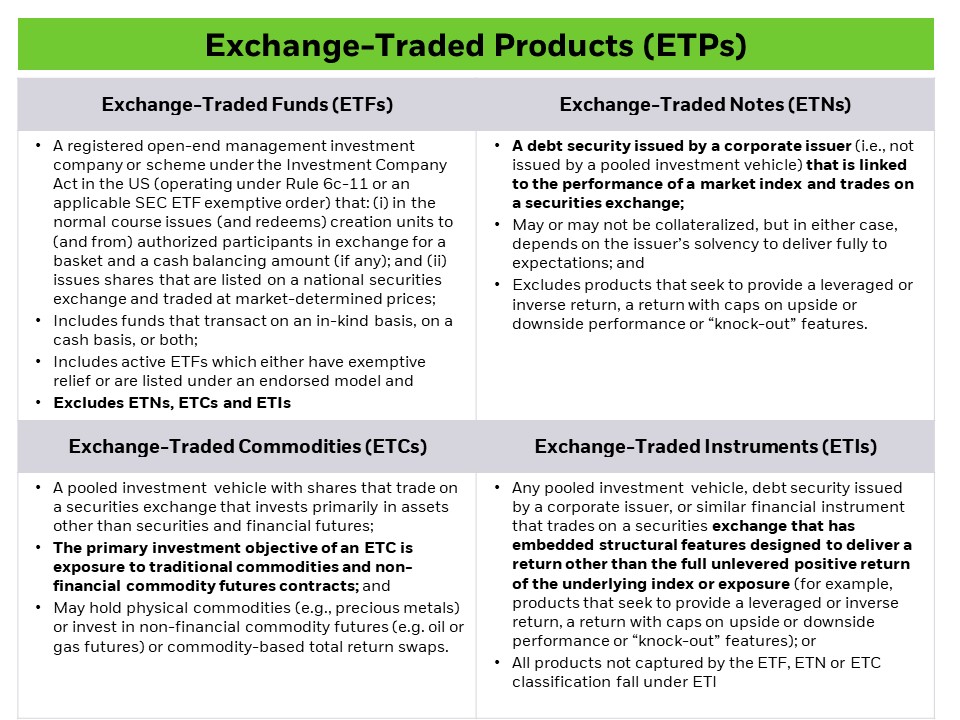INVESTMENT STRATEGIES
ETF EDUCATION
Adviser Centre
Forms & documents
As the Exchange Traded Products (ETPs) market in Australia has grown over the last ten years, so has the number and variety of products, with very different risk profiles.
In Australia, information sheet (INFO 230) provides guidance for licensed exchanges that admit ETPs1 and outlines the distinction between ETF (exchange traded fund) and ETMF (exchange traded managed fund), as well as some additional considerations for ETPs, that have unique or novel features (such as synthetic or active ETFs). As the industry has adapted to the growth of ETPs in Australia, this guidance has been updated but not retrospectively applied, and while understood by exchanges and product issuers, most investors and media continue to adopt “ETF” as a blanket term for any product that offers exchange tradability. Many products that can be grouped under the term “ETF” have very distinct risk profiles and/or features. For example, some use futures to deliver leveraged or inverse performance to an index, and other vehicles are exposed to the creditworthiness of the issuer of the product, which is like a debt instrument. As such, we believe that requirements should exist that constrain the application of the term “ETF” to a specific subset of ETPs (see below categories ) and that other types of ETPs should be put in different categories more suited to their features and objective.
A clear and consistent categorization of the different types of ETPs will help investors and the professionals who engage with them (including advisors and broker-dealers) complete a more thorough due diligence process when investing in these products.
Recent market events have demonstrated the need for clearer distinctions between different types of ETPs. In April 2020, a dramatic decline in oil prices resulted in a 3x levered crude oil-linked ETP in the US being delisted with an expected value of zero dollars per share.2 While the decline in value was extreme, this product actually performed as designed. Similar examples exist in Australia with large value changes during the volatility in March/April in single commodity products such as oil ETPs and levered/inverse exposures.
While guidance for licensed exchanges1 in Australia has provided some ETP naming conventions for investors, the differences in risk return profiles between ETPs may be improved with a clear and simple classification that is adopted within the ETP name (for both existing and new products) and all product materials as well as communication in media.
In the US, while regulators have worked to promote transparency around these products, including disclosure requirements they have not yet adopted a classification system that categorizes ETPs formally based on certain key features and risk profiles.3
To help advance clearer classifications, on May 13, 2020, an industry coalition of leading ETP sponsors, including BlackRock, Charles Schwab Investment Management, Fidelity Investments, Invesco, State Street Global Advisors and Vanguard, submitted a letter to each U.S. stock exchange with ETP listings—NYSE, Nasdaq, and Cboe—to enlist their support implementing more consistent identifications and categorizations of ETPs.
Many players in the ETP ecosystem, from issuers to exchanges, are well-positioned to help advance ETP classifications. Incorporating consistent ETP nomenclature at the exchange data feed level would not only benefit investors by providing more clarity into specific product characteristics, but also assist brokerage platforms in implementing point-of-sale guardrails to better protect investors, as well as helping innovation in a way which doesn’t create confusion.
While each jurisdiction needs to take into account the local market considerations, we believe that adopting a simple and comprehensive ETP classification is relevant for jurisdictions, beyond the US, including Australia.
